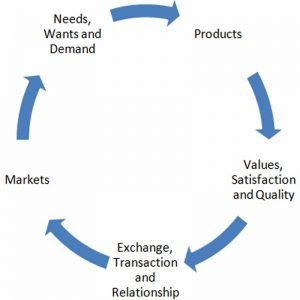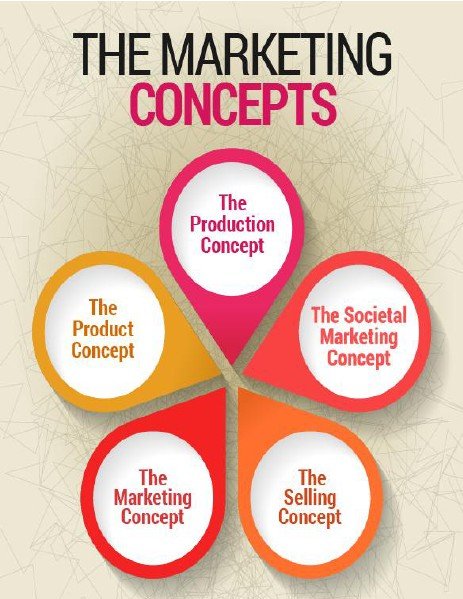Marketing Concepts to Understand the Markets
The success of any organization depends on its efforts towards the customer satisfaction by finding their needs and wants and fulfilling through the process of exchanging goods or services and creating value. Marketing concept depends on the belief that the marketers should identify the day to day changing tastes and preferences of the customers. Modern trends are also forcing the organizations to produce goods or services according to the changing needs and want and in addition creating value to their money, so instead of concentrating on competitor’s strategies knowing the customer’s mindset can give better results. Most of the companies are experiencing the optimization of the sales and profits with the better customer relations.

Needs, Wants, and Demands
Customer needs wants and demands are ruling the markets, human needs are endless identifying and satisfying those needs in the field of business is becoming a day to day challenge to the marketers. Needs are the most important and basic requirements which should be fulfilled for the survival of individuals, for example, water, air, food, and shelter etc, so these needs make the customers buy the products. However in the case wants, it gives them a chance to think and buy, these wants are the desire to get something which is creating value to their money. Wants may be stated as the desire to get something very particular. For example, thirst is a need, it makes to fulfill that need by drinking water, but wants are higher level needs which give a chance to select what to drink to fulfill the desire.
Product
The product may be tangible or intangible which is offered by the marketers to create value for the customer’s money and to fulfill the needs and wants of the customers. During olden days products are produced according to the belief, tastes, and preferences of the marketers, but in the modern days, markets are ruling and deciding what to produce and what price to fix the product. In order to survive in the current situations, marketers should identify the market’s pulse while taking the production decisions. This is the reason why substitute goods are occupying the markets and getting success, they research the needs to be attained and apply strategies according to it to fulfill the gap by producing superior quality products with lower prices. Here, quality is not only the variable but, product’s price, features and availability also shows the effect on the buying decisions of the customers.
Value and satisfaction
Value and satisfaction play a major role in consumer behavior and decision making, willingness to buy and ability to pay decides which product to buy. So, though there are many similar products, then also customers decide and select one among them, it completely depends on their perception levels and value created by the products to their money. The quality of the product, features, and price of the products determines the value created and level of satisfaction in the minds of the customers. Here, product’s capacity to satisfy the customers becomes the value and it ultimately decides the buying behavior, so creating value to the customer’s money not only satisfies the customers but it acts as a competitive advantage to survive in the long run.
Exchange, Transactions, and Relationship
Marketing is the process of exchanging offerings and creating value to the customer’s money in order to fulfill the needs of the customers and to maximize the profits. The exchange is the basic concept to run the business or to fulfill the market demand, and here transactions may be monetary or nonmonetary, it involves the transaction of goods or services which may be in return for money or other goods or services. Exchange and transactions can mutually benefit the both parties by creating value. Profitable transactions and customer satisfaction can build good relations and facilitates continuing the process of selling and buying.
Markets
Markets consist of potential buyers and marketers in order to facilitate the process of exchange of goods and services and to create the value. Markets are various types which include resource markets, consumer markets, manufacturing markets, intermediary markets and so on and these markets decide the success of the organizations. Production decisions always depend on the size of the markets, target markets, availability of the products, substitute products, availability of the complementary products, price, place and promotion shows influence on the exchange of products and services in the markets.

Production concept
Production concept guides the managers to take decisions related to the increase or decrease in production levels. It depends on the cost of production, price, economies of scale, product’s life cycle, mass production, demand, quality, and design. If the cost of production increases then the price increases it results in a decrease in sales because higher prices make customers to buy substitute products or similar products with low prices. Likewise, the economics of scale facilitates per unit cost reduction and price reduction, it makes customers buy more and creates demand for the product. So the markets should take decisions depending on the market situations, price, quality and demand of the product.
Product concept
Quality and features of the product make buyers to buy the product, here day to day changing customer needs and preferences challenges the organizations to take strategic decisions in order to satisfy the potential customers. Technological development, research, and innovations facilitate organizations to produce new products, these new products creates pressure on other organizations to modify the existed products with new features and better quality. Offering products with minor changes in quality and features may not bring desired results, so producing products and services according to the tastes and preferences of the customers and other possible factors like price and availability can give better results.

Selling concept
Selling concept guides the organizations in maximizing sales through creating awareness in the minds of the customers about the product or service. Most of the customers do not voluntarily buy products without the company’s advertisements, offers and strategies of the marketers. Selling concept states that the marketers should create sales to maximize profits or to pay the markets in terms of losses. The quality, price, and features may help to maximize the sales but the initial efforts should be contributed in the form of advertisements to create awareness and to start sales.
So the marketers should take decisions and play strategies depending on the market situations and nature of the business, trying to match the product’s features and price, with the customer’s tastes and preferences and their affordability to buy the product can give better results. After quality and features, affordability is one of the main reasons for selecting substitute products or product’s with low prices. Reduction in cost of production, the economics of scale, mass production and market research facilitates producing innovative products with low prices. Maintaining quality and consistency also maximize customer loyalty and brand image. Concentrating on the societal marketing concept can also give better results in gaining the customer loyalty and competitive advantage.

- Marketing concept involves knowing the tastes and preferences of the customers
- It brings out major difference between the needs and wants which helps in taking strategic decisions
- It helps in producing the products according to the customer’s affordability.
- It explains the relation between cost of production, price and demand for the products and finally guides the managers to take better production decisions.
- It creates a greater scope of research and innovations to produce new products in order to satisfy the potential customer’s needs.
- Societal marketing concept helps in direct the marketers in doing social welfare activities
- It helps in taking decisions related to long-term profitability and customer loyalty.
- It guides the marketers to put their efforts and to take strategic decisions in order to create awareness about the product.
- It explains the concept of exchange, transaction, satisfaction and value creation for the purpose of taking strategic decisions.




